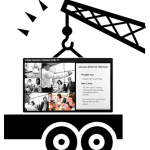Another great article and spot on. In most of the meetings I attend clients have already decided to do an elearning course. Altough they can often answer the question:”What is the topic?”, the question:””What are the objectives and why?” is a different matter. I see a lot of “Awareness” training popping up, typically the objective doesn’t get much further than “to inform people” and “hope that they will change behavior if needed”. How would You set some tangible goals for an awareness training?
These Simple Tips Will Help You Build the Right E-Learning
September 13th, 2011
We’re in the middle of beta testing a new product. It’s an interesting process because I get to see how people approach their projects and the steps they use to solve problems and find solutions.
I had a conversation with a beta tester who was struggling with doing something. One reason for his struggle was that he was applying production techniques he used for a different product to the beta software. So things weren’t working as he had planned.
His struggle was one common to many of us. He started with a solution and then tried to make it fit the problem he was trying to solve. He started with a production process (solution) and then tried to force his objective (completing his project) to the solution.
He should have stepped away from the solution, taken a closer look at what he wanted to do, and then look at the options he had for meeting his objective. At that point he could have determined the most effective solution for meeting his goals. It would have saved him some time and frustration.
Starting with a solution isn’t an issue isolated to those beta testing software. It’s really an issue with a lot of training and elearning programs. How often have you been in a meeting where the client says, “We need a new course,” before they even presented their objectives? It seems that almost every time I start a project, the client’s already determined that some sort of training is required even if that’s not always the case.
Recognize that elearning courses aren’t the objective.
E-learning courses (and training programs for that matter) exist to meet objectives. They really aren’t THE objective. They’re solutions. If you start with a pre-determined solution without evaluating your objectives, there’s a good chance that you won’t meet your objectives.
It’s easy to be seduced by solutions because these seem tangible and active, especially with the simple and quick authoring of rapid elearning tools. They allow you to easily create solutions. Need a quick course? No problem. I can get one to by the end of the week. And many times you’ll be the rock star at work because you’ll have this cool, interactive elearning course to show off. That’s a lot more tangible than a brainstorm list of possible solutions.
Step away from the solutions.
Before committing time and resources to a solution make sure you fully understand the objectives. What do you hope to accomplish? Once you’ve done that, you’ll be able to look at all of the solutions available to you and then decide which is best to meet your objectives.
Another reason to step away from the solution is that we tend to get enamored with features and then work to get our objectives to meet the feature whether or not it adds real value.
Collect data to help make an informed decision.
We’re an information-driven culture so it’s easy to understand why we fall back on the need to create a course. The thought is that if only people knew more they’d be able to make better decisions and accomplish their goals. So a lot of our training is focused on pushing information to people so that they can know more.
Let’s take a step back and do the “knowing more” at the front end. What do you know about your objectives? Why do they exist? Usually there’s some sort of gap between where you are and where you want to be after the training is implemented.
What’s causing the gap? Is it really a lack of knowledge or understanding, which may require training? Perhaps there’s a lack of resources? Maybe there’s an issue with motivation.
As you can imagine, not all gaps are covered by a training program. Many times there are issues like performance support, management styles, personal motivation, or available resources. No matter how hard you try, the elearning course won’t fill those gaps.
Determine the best solution.
Once you’ve identified your objectives, you’re able to determine the best solution to meet them. Somewhere in the process you’ll know if an elearning course is part of the solution. If it’s not, then you’ve saved the organization time and money. On the other hand, if it is, you’ll have a better handle on the objectives and what you need to do to meet them. You’ll also have some metrics to compare the pre- and post- course results.
Elearning courses play a role in your training initiatives. But they’re not always the right solution. Before you invest a lot of time and money into building courses, make sure you know that the course will meet your objectives.
And then when you do start building the course, worry less about using the feature and more about what you want to do. Then figure out which features let you do that best.
E-learning books don’t usually deal with this type of stuff and the decisions you have to make prior to building the course. But your successful implementation of elearning requires that you’re building the right type of courses (if at all). While you don’t need an MBA in business, you should be familiar with performance consulting at some level.
Here are a few book recommendations.
- The Performance Consultant’s Fieldbook
- Performance Consulting
- First Things Fast
- Training Design Basics via Scott in comments
The links to Amazon books produce a slight commission.
If you want to recommend a good resource or performance consulting blog, feel free to mention it in the comments section.
Events
- Everyday. Check out the weekly training webinars to learn more about Rise, Storyline, and instructional design.
Free E-Learning Resources
 |
 |
 |
|
Want to learn more? Check out these articles and free resources in the community. |
Here’s a great job board for e-learning, instructional design, and training jobs |
Participate in the weekly e-learning challenges to sharpen your skills |
 |
 |
 |
|
Get your free PowerPoint templates and free graphics & stock images. |
Lots of cool e-learning examples to check out and find inspiration. |
Getting Started? This e-learning 101 series and the free e-books will help. |
16 responses to “These Simple Tips Will Help You Build the Right E-Learning”
Thank you for your refreshing article on building the right E-Learning. It should have been subtitled, “To Build or Not to Build.” Nonetheless, I appreciate your level-headed recommendation to analyze the situation before you synthesize a response (it’s not a solution until it actually solves a problem).
For other resources that take a similar view, see http://www.sixboxes.com. Six Boxes is Carl Binder’s plain language approach to Tom Gilbert’s Behavior Engineering model. Tom was among the earliest thinkers to take a systems approach to solving performance problems in business.
While the six boxes guide your analysis of each of the major categories of influence on performance, it’s the last step in the performance chain. Before you look at ways to improve employee performance, you need to ascertain that the employee performance needs improving.
You do that by first determining if there is or will be a gap in organizational performance. No gap? No solution, needed.
Tying your potential project to a gap in organizational performance ensures relevance and provides useful metrics for determining the worth of your potential project.
Next, you determine which specific job outputs, if any, are (or will be) contributing to the organizational gap. No gap? The solution may be beyond your control (factors external to your organization may be at work). A policy or strategic change may be needed.
However, if there is a relevant gap in job outputs, then determine which tasks are relevant to producing the deficient job output. And, of those tasks, determine which are not being done or are being done poorly.
Finally, given a list of deficient tasks, you are ready to determine which combination of factors that influence behavior (the targeted tasks) are missing or deficient and whether or not there are barriers to successful performance that need to be removed or mitigated. This is when the six boxes are useful.
One of the potential solutions, training, is required only if the the task deficiency is due, in part or completely, to a deficiency in skill or knowledge and that the deficiency cannot be dealt with by using a well-designed job aid.
While E-Learning is a neat media and fun to develop, it is not a panacea for all skill/knowledge deficiencies. Let’s face it, at some point, some physical skills need practice with feedback in a high-level simulation (examples: fire-fighting, mountain climbing, brain surgery, and competing in a triathlon). Yes, E-Learning can help prepare for those simulations–but sooner or later, you have to leave the comfortable confines of your desk and actually practice the skills.
-End of sermon-
[…] More here: These Simple Tips Will Help You Build the Right E-Learning » The Rapid eLearning Blog […]
This is a great topic. Studies have pointed to the fact that training is the correct intervetion for a performance issue in the workplace about 11% of the time. That means that a performance issue will not be corrected using training the other 89% of the time. A book I am currently reading titled: Training Design Basics by Saul Carliner (2003) is a great resource to learn about performing a needs analysis before you begin instructional design.
Thanks again for pointing this issue out to your readers. If they can do the job task if their life depended on it, training is not the solution.
Scott
I think about this statement daily:
“As you can imagine, not all gaps are covered by a training program. Many times there are issues like performance support, management styles, personal motivation, or available resources.”
I’ll add an issue to that list: a culture resistant to change. A company’s culture will not change just because we deploy training. The issue runs much deeper than a lack of knowledge.
For the most part, my company is aware of this, and we’re taking major strides in the correct direction to change the mentality of our company’s culture. I look forward to that day because I identify with this article far more than I wish I did!
For my two cents there are two steps of analysis:
1 Training Needs Analysis – from my experience there a four core components that need to be considered:
– What do they need to be able to do and to what level?
– If they are new staff, when do you expect them to be able to do this and by when?
– How often do they need to do each task identified?
– What other skills do they need to have to be able to do the job competently? (ie. LLN, do they need to be able to touch type etc)
2 Skill Gap Analysis: Three key questions:
– What can they do now, what can’t they do now?
– For the stuff that they can do, to what level can they do it now?
– Why can’t they do these things now and / or why can’t they do these to the required levels? (ie. the online support tool is deficient, the system is slow, they can’t touch type etc)
In my time, I’ve uncovered doing these two processes a whole bunch of issues that impact staff performance:
1 Staff with the wrong skills sets are hired
2 The systems and processes don’t allow even a high performer to do the job to the required level
3 Training too much stuff or training at the wrong time
4 Not having realistic KPI milestones for new staff
5 Only incorporating formal learning processes into the overal learning strategy – no informal or osmotic components
6 Poor or non-existent tools to support staff on-job
7 Training practices that are misaligned or not aligned at all to the ‘real world’
Thanks for this post! It was very useful! Now I’m thinking about my objetives with distance education! It isnt’ the solution, it’s just the way to find the solution!
Your words: “If you start with a pre-determined solution without evaluating your objectives, there’s a good chance that you won’t meet your objectives.” My objectives are can the people see the one better way to learn, just it! The educations tools can help, but they aren’t the solution! Thanks!
A great reminder, Tom, that the lure of the “e” shouldn’t replace the due dilligence of figuring out the “learning”, and that’s why I pull out the ol’ textbooks when I’ve got to sell the idea of the gap analysis. In the words of Dick & Carey: “Perhaps the most critical event in the instructional design process is identifying the instructional goal. If done improperly, even elegant instruction may not serve the organization’s or the intended learners’ real needs.” (Dick, Walter, Dick, Lou and Carey, James “The Systematic Design of Instruction: Sixth Edition” 2005, Allyn & Bacon, Boston. p. 15).
It’s a time sensitive culture, and it’s unpopular to be the voice of reason in a room full of people shouting “Get on the train!” But you’ve got to know where the train is supposed to go, for crying out loud! Stocking the dining car with caviar doesn’t change the fact that it’s a mode of transportation – if you were trying to get to Chicago and ended up in Peoria, that caviar-laden train didn’t do the job.
Reminds me of a favorite cartoon, republished in James P. Lewis’ “Fundamentals of Project Management”( 2007, Amacom, New York). The pictures aren’t all that cool, but it goes a little something like this:
Project Initiation
Wild Enthusiasm
Disillusionment
Chaos
Search for the Guilty
Punish the Innocent
Promotion of the Nonparticipants
Definition of the Requirements
And who wants to be on THAT train!
[…] […]
[…] These Simple Tips Will Help You Build the Right E-Learning […]
I LIKE IT VERYWELL
Debbie said: “Perhaps the most critical event in the instructional design process is identifying the instructional goal.” For me it’s very difficult chose to goal, because when I think about what to teach, it’s one obligation think for who I’ll teach. But the “who” is the problem, there are many students, with many differents goals, and differents ways to find their goals. To solve this problem, I’ve been using a method that is simple and can be changed whenever it’s necessary.
for me it’s very difficult to chose the goal, because when i think about what teaching, it’s fundamental to think about the people i’m teaching. but the “subject” is the problem. there are many students with theirs many differents goals, and differents ways of achieving it to solve this problem, i’ve been using a method that is simple and can be changed whenever it’s necessary.
“Sorry for the last post”








0
comments